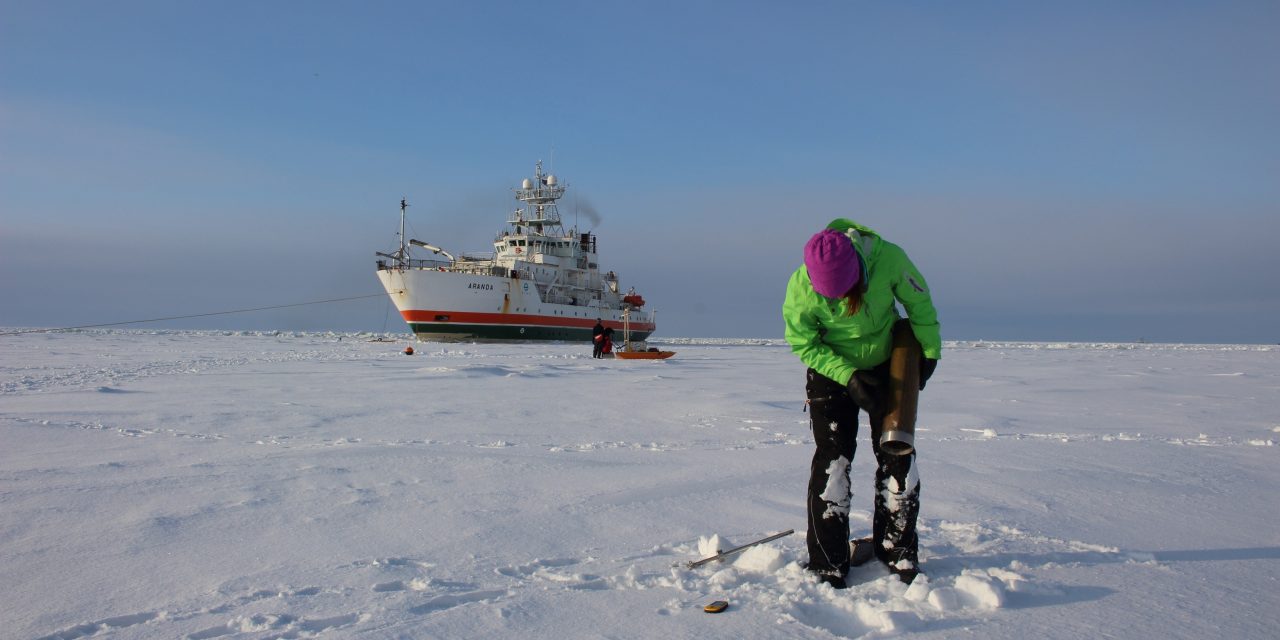How Do We Still Not Know How Much it Snows in the Arctic?
by Dr Sammie BuzzardThere’s a lot of snow in the Arctic. But you might be surprised to know that scientists don’t actually know how much. And that matters.

Working on the sea ice. Photo credit: Rachel Tilling (Centre for Polar Observation and Modelling).
As a scientist who used to study Antarctica I know first hand that getting information about our polar regions can be incredibly difficult. Yet even I was surprised when I switched to working on Arctic sea ice (the frozen layer of ocean water that sits on top of the Arctic ocean) that we knew so little about the Arctic- we’ve known about it much longer, and people have lived there for thousands of years.
Finding out how much snow there is in the Arctic, especially on top of the sea ice, turns out to be incredibly difficult. We have some measurements, ranging from Russian stations that were frozen into the ice in the 1950s to current measurements made from planes flown by NASA and from scientists out in the field, such as Dr Helen Czerski . Satellites give us some limited information, but to really understand the satellite information we need more measurements on the ground and the measurements we have are few and far between.
If you think about it, even if we did have lots of weather stations all over the Arctic to give us regular snow updates, snow would be incredibly difficult to measure. It’s not like measuring rain that can just fill up a rain gauge, snow falls in different types and it also changes once it falls; it compacts, it gets blown around by the wind and it melts and sometimes refreezes. After all, it’s a well-known pub quiz fact that there are more than 50 Inuit words for snow (or 40, or 100 depending on which pub quiz you frequent) so even ‘how much’ is not a straight forward question when it comes to snow.

Photo credit: Rachel Tilling (Centre for Polar Observation and Modelling).
But why does it matter if there’s snow or not when so much of the Arctic ocean is frozen ice anyway? Well snow is more reflective than ice and is also a great insulator (think of it as a blanket on top of the ice), so bare sea ice will absorb more energy from the sun than snow-covered sea ice: bad news for a warming Arctic. The snow can also melt in summer, forming ponds on top of the sea ice, causing it to melt even more quickly. Snow also makes using satellites to measure the sea ice more complicated; it can affect how closely radar signals can measure the sea ice surface so to know how much sea ice we have we need to know how much snow we have.
So we need to know more about the snow and that’s what my current job at the Centre for Polar Observation and Modelling at University College London currently involves. A friend of mine once reacted to me describing this with, “What that’s your whole job, to work out how much snow there is?” Yes. It is (and the job of a surprising number of others worldwide), and even with the satellite information, weather and climate models we have, we still don’t quite know. We’re getting better at it but we’re not there yet.
The Cosmic Shambles Network relies on your support on pledges via Patreon so we can continue to provide great, new, exciting content without the need for third party ads or paywalls.
For as little as $1 a month you can support what we do and get some great rewards for doing so as well. Click the Patreon logo to pledge or find out more.
 Dr Sammie Buzzard is part of the Centre for Polar Observation and Modelling and is based at the University College London. Her research focuses on performing calculations of snow on sea ice and sea ice thickness using atmospheric reanalysis data and sea ice thickness datasets from different satellites, as part of the European Space Agency funded Arctic+ project.
Dr Sammie Buzzard is part of the Centre for Polar Observation and Modelling and is based at the University College London. Her research focuses on performing calculations of snow on sea ice and sea ice thickness using atmospheric reanalysis data and sea ice thickness datasets from different satellites, as part of the European Space Agency funded Arctic+ project.
If you would like to reuse this content please contact us for details
Subscribe to The Cosmic Shambles Network Mailing list here.



Really great article